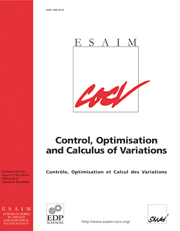Crossref Citations
This article has been cited by the following publications. This list is generated based on data provided by
Crossref.
Freiberger, Manuel
Clason, Christian
and
Scharfetter, Hermann
2010.
Adaptation and focusing of optode configurations for fluorescence optical tomography by experimental design methods.
Journal of Biomedical Optics,
Vol. 15,
Issue. 1,
p.
016024.
Ito, Kazufumi
Jin, Bangti
and
Takeuchi, Tomoya
2011.
A Regularization Parameter for Nonsmooth Tikhonov Regularization.
SIAM Journal on Scientific Computing,
Vol. 33,
Issue. 3,
p.
1415.
Wachsmuth, Gerd
and
Wachsmuth, Daniel
2011.
Convergence and regularization results for optimal control problems with sparsity functional.
ESAIM: Control, Optimisation and Calculus of Variations,
Vol. 17,
Issue. 3,
p.
858.
Ito, Kazufumi
and
Kunisch, Karl
2011.
Karush–Kuhn–Tucker Conditions for Nonsmooth Mathematical Programming Problems in Function Spaces.
SIAM Journal on Control and Optimization,
Vol. 49,
Issue. 5,
p.
2133.
Casas, Eduardo
Herzog, Roland
and
Wachsmuth, Gerd
2012.
Approximation of sparse controls in semilinear equations by piecewise linear functions.
Numerische Mathematik,
Vol. 122,
Issue. 4,
p.
645.
Herzog, Roland
Stadler, Georg
and
Wachsmuth, Gerd
2012.
Directional Sparsity in Optimal Control of Partial Differential Equations.
SIAM Journal on Control and Optimization,
Vol. 50,
Issue. 2,
p.
943.
Clason, Christian
and
Kunisch, Karl
2012.
A measure space approach to optimal source placement.
Computational Optimization and Applications,
Vol. 53,
Issue. 1,
p.
155.
Casas, Eduardo
Herzog, Roland
and
Wachsmuth, Gerd
2012.
Optimality Conditions and Error Analysis of Semilinear Elliptic Control Problems with $L^1$ Cost Functional.
SIAM Journal on Optimization,
Vol. 22,
Issue. 3,
p.
795.
Casas, Eduardo
Herzog, Roland
and
Wachsmuth, Gerd
2012.
Large-Scale Scientific Computing.
Vol. 7116,
Issue. ,
p.
16.
Casas, Eduardo
Clason, Christian
and
Kunisch, Karl
2012.
Approximation of Elliptic Control Problems in Measure Spaces with Sparse Solutions.
SIAM Journal on Control and Optimization,
Vol. 50,
Issue. 4,
p.
1735.
Brunner, Patricia
Clason, Christian
Freiberger, Manuel
and
Scharfetter, Hermann
2012.
A deterministic approach to the adapted optode placement for illumination of highly scattering tissue.
Biomedical Optics Express,
Vol. 3,
Issue. 7,
p.
1732.
Leykekhman, Dmitriy
and
Vexler, Boris
2013.
Optimal A Priori Error Estimates of Parabolic Optimal Control Problems with Pointwise Control.
SIAM Journal on Numerical Analysis,
Vol. 51,
Issue. 5,
p.
2797.
Hoeltgen, Laurent
Setzer, Simon
and
Weickert, Joachim
2013.
Energy Minimization Methods in Computer Vision and Pattern Recognition.
Vol. 8081,
Issue. ,
p.
151.
Casas, E.
and
Zuazua, E.
2013.
Spike controls for elliptic and parabolic PDEs.
Systems & Control Letters,
Vol. 62,
Issue. 4,
p.
311.
Pieper, Konstantin
and
Vexler, Boris
2013.
A Priori Error Analysis for Discretization of Sparse Elliptic Optimal Control Problems in Measure Space.
SIAM Journal on Control and Optimization,
Vol. 51,
Issue. 4,
p.
2788.
Amstutz, Samuel
and
Laurain, Antoine
2013.
A semismooth Newton method for a class of semilinear optimal control problems with box and volume constraints.
Computational Optimization and Applications,
Vol. 56,
Issue. 2,
p.
369.
Caponigro, Marco
Fornasier, Massimo
Piccoli, Benedetto
and
Trélat, Emmanuel
2013.
Sparse stabilization and optimal control of the Cucker-Smale model.
Mathematical Control & Related Fields,
Vol. 3,
Issue. 4,
p.
447.
Bredies, Kristian
and
Pikkarainen, Hanna Katriina
2013.
Inverse problems in spaces of measures.
ESAIM: Control, Optimisation and Calculus of Variations,
Vol. 19,
Issue. 1,
p.
190.
Fornasier, Massimo
Piccoli, Benedetto
and
Rossi, Francesco
2014.
Mean-field sparse optimal control.
Philosophical Transactions of the Royal Society A: Mathematical, Physical and Engineering Sciences,
Vol. 372,
Issue. 2028,
p.
20130400.
Clason, Christian
and
Kunisch, Karl
2014.
Multi-bang control of elliptic systems.
Annales de l'Institut Henri Poincaré C, Analyse non linéaire,
Vol. 31,
Issue. 6,
p.
1109.


